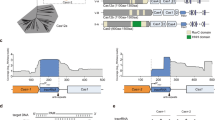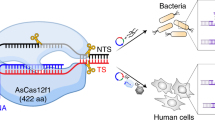Abstract
CRISPR–Cas12f nucleases are currently one of the smallest genome editors, exhibiting advantages for efficient delivery via cargo-size-limited adeno-associated virus delivery vehicles. Most characterized Cas12f nucleases recognize similar T-rich protospacer adjacent motifs (PAMs) for DNA targeting, substantially restricting their targeting scope. Here we report the cryogenic electron microscopy structure and engineering of a miniature Clostridium novyi Cas12f1 nuclease (CnCas12f1, 497 amino acids) with rare C-rich PAM specificity. Structural characterizations revealed detailed PAM recognition, asymmetric homodimer formation and single guide RNA (sgRNA) association mechanisms. sgRNA engineering transformed CRISPR–CnCas12f1, which initially was incapable of genome targeting in bacteria, into an effective genome editor in human cells. Our results facilitate further understanding of CRISPR–Cas12f1 working mechanism and expand the mini-CRISPR toolbox.

This is a preview of subscription content, access via your institution
Access options
Access Nature and 54 other Nature Portfolio journals
Get Nature+, our best-value online-access subscription
$29.99 / 30 days
cancel any time
Subscribe to this journal
Receive 12 print issues and online access
$259.00 per year
only $21.58 per issue
Buy this article
- Purchase on Springer Link
- Instant access to full article PDF
Prices may be subject to local taxes which are calculated during checkout






Similar content being viewed by others
Data availability
The structure of the CnCas12f1–sgRNA–dsDNA complex has been deposited in the Protein Data Bank under accession code 8HR5. Next-generation sequencing data are available at the National Center for Biotechnology Information Sequence Read Archive under accession codes PRJNA990823, PRJNA967838, PRJNA967688, PRJNA970104 and PRJNA970076. Plasmids can be accessed in Addgene under accession codes 204996 and 204999. Source data are provided with this paper.
References
Ishino, Y., Shinagawa, H., Makino, K., Amemura, M. & Nakata, A. Nucleotide sequence of the iap gene, responsible for alkaline phosphatase isozyme conversion in Escherichia coli, and identification of the gene product. J. Bacteriol. 169, 5429–5433 (1987).
Makarova, K. S. et al. Evolutionary classification of CRISPR–Cas systems: a burst of class 2 and derived variants. Nat. Rev. Microbiol. 18, 67–83 (2020).
Jinek, M. et al. A programmable dual-RNA-guided DNA endonuclease in adaptive bacterial immunity. Science 337, 816–821 (2012).
Cong, L. et al. Multiplex genome engineering using CRISPR/Cas systems. Science 339, 819–823 (2013).
Gasiunas, G., Barrangou, R., Horvath, P. & Siksnys, V. Cas9–crRNA ribonucleoprotein complex mediates specific DNA cleavage for adaptive immunity in bacteria. Proc. Natl Acad. Sci. USA 109, E2579–E2586 (2012).
Zetsche, B. et al. Cpf1 is a single RNA-guided endonuclease of a class 2 CRISPR–Cas system. Cell 163, 759–771 (2015).
Dong, D. et al. The crystal structure of Cpf1 in complex with CRISPR RNA. Nature 532, 522–526 (2016).
Yamano, T. et al. Crystal structure of Cpf1 in complex with guide RNA and target DNA. Cell 165, 949–962 (2016).
Abudayyeh, O. O. et al. C2c2 is a single-component programmable RNA-guided RNA-targeting CRISPR effector. Science 353, aaf5573 (2016).
Doudna, J. A. The promise and challenge of therapeutic genome editing. Nature 578, 229–236 (2020).
Liu, J. J. et al. CasX enzymes comprise a distinct family of RNA-guided genome editors. Nature 566, 218–223 (2019).
Harrington, L. B. et al. Programmed DNA destruction by miniature CRISPR–Cas14 enzymes. Science 362, 839–842 (2018).
Karvelis, T. et al. PAM recognition by miniature CRISPR–Cas12f nucleases triggers programmable double-stranded DNA target cleavage. Nucleic Acids Res. 48, 5016–5023 (2020).
Wu, Z. et al. Programmed genome editing by a miniature CRISPR–Cas12f nuclease. Nat. Chem. Biol. 17, 1132–1138 (2021).
Takeda, S. N. et al. Structure of the miniature type V-F CRISPR–Cas effector enzyme. Mol. Cell 81, 558–570 (2021).
Xiao, R., Li, Z., Wang, S., Han, R. & Chang, L. Structural basis for substrate recognition and cleavage by the dimerization-dependent CRISPR–Cas12f nuclease. Nucleic Acids Res. 49, 4120–4128 (2021).
Wang, Y. et al. Guide RNA engineering enables efficient CRISPR editing with a miniature Syntrophomonas palmitatica Cas12f1 nuclease. Cell Rep. 40, 111418 (2022).
Yan, W. X. et al. Functionally diverse type V CRISPR–Cas systems. Science 363, 88–91 (2019).
Zhang, H., Li, Z., Xiao, R. & Chang, L. Mechanisms for target recognition and cleavage by the Cas12i RNA-guided endonuclease. Nat. Struct. Mol. Biol. 27, 1069–1076 (2020).
Huang, X. et al. Structural basis for two metal-ion catalysis of DNA cleavage by Cas12i2. Nat. Commun. 11, 5241 (2020).
Zhang, B. et al. Mechanistic insights into the R-loop formation and cleavage in CRISPR–Cas12i1. Nat. Commun. 12, 3476 (2021).
Urbaitis, T. et al. A new family of CRISPR-type V nucleases with C-rich PAM recognition. EMBO Rep. 23, e55481 (2022).
Pausch, P. et al. CRISPR–CasΦ from huge phages is a hypercompact genome editor. Science 369, 333–337 (2020).
Pausch, P. et al. DNA interference states of the hypercompact CRISPR–CasΦ effector. Nat. Struct. Mol. Biol. 28, 652–661 (2021).
Carabias, A. et al. Structure of the mini-RNA-guided endonuclease CRISPR–Cas12j3. Nat. Commun. 12, 4476 (2021).
Al-Shayeb, B. et al. Diverse virus-encoded CRISPR–Cas systems include streamlined genome editors. Cell 185, 4574–4586 (2022).
Karvelis, T. et al. Transposon-associated TnpB is a programmable RNA-guided DNA endonuclease. Nature 599, 692–696 (2021).
Altae-Tran, H. et al. The widespread IS200/IS605 transposon family encodes diverse programmable RNA-guided endonucleases. Science 374, 57–65 (2021).
Schuler, G., Hu, C. & Ke, A. Structural basis for RNA-guided DNA cleavage by IscB-ωRNA and mechanistic comparison with Cas9. Science 376, 1476–1481 (2022).
Kato, K. et al. Structure of the IscB-ωRNA ribonucleoprotein complex, the likely ancestor of CRISPR–Cas9. Nat. Commun. 13, 6719 (2022).
Bigelyte, G. et al. Miniature type V-F CRISPR–Cas nucleases enable targeted DNA modification in cells. Nat. Commun. 12, 6191 (2021).
Kim, D. Y. et al. Efficient CRISPR editing with a hypercompact Cas12f1 and engineered guide RNAs delivered by adeno-associated virus. Nat. Biotechnol. 40, 94–102 (2022).
Xu, X. et al. Engineered miniature CRISPR–Cas system for mammalian genome regulation and editing. Mol. Cell 81, 4333–4345 (2021).
Walton, R. T., Hsu, J. Y., Joung, J. K. & Kleinstiver, B. P. Scalable characterization of the PAM requirements of CRISPR–Cas enzymes using HT-PAMDA. Nat. Protoc. 16, 1511–1547 (2021).
Kurihara, N. et al. Structure of the type V-C CRISPR–Cas effector enzyme. Mol. Cell 82, 1865–1877 (2022).
Yang, H., Gao, P., Rajashankar, K. R. & Patel, D. J. PAM-dependent target DNA recognition and cleavage by C2c1 CRISPR–Cas endonuclease. Cell 167, 1814–1828 (2016).
Burstein, D. et al. New CRISPR–Cas systems from uncultivated microbes. Nature 542, 237–241 (2017).
Kong, X. et al. Engineered CRISPR–OsCas12f1 and RhCas12f1 with robust activities and expanded target range for genome editing. Nat. Commun. 14, 2046 (2023).
Shmakov, S. et al. Discovery and functional characterization of diverse class 2 CRISPR–Cas systems. Mol. Cell 60, 385–397 (2015).
Tsuchida, C. A. et al. Chimeric CRISPR–CasX enzymes and guide RNAs for improved genome editing activity. Mol. Cell 82, 1199–1209 (2022).
Wu, W. Y. et al. The miniature CRISPR–Cas12m effector binds DNA to block transcription. Mol. Cell 82, 4487–4502 (2022).
Li, H. Aligning sequence reads, clone sequences and assembly contigs with BWA-MEM. Preprint at arXiv https://doi.org/10.48550/arXiv.1303.3997 (2013).
Li, H. et al. The Sequence Alignment/Map format and SAMtools. Bioinformatics 25, 2078–2079 (2009).
Mastronarde, D. N. Automated electron microscope tomography using robust prediction of specimen movements. J. Struct. Biol. 152, 36–51 (2005).
Zheng, S. Q. et al. MotionCor2: anisotropic correction of beam-induced motion for improved cryo-electron microscopy. Nat. Methods 14, 331–332 (2017).
Punjani, A., Rubinstein, J. L., Fleet, D. J. & Brubaker, M. A. cryoSPARC: algorithms for rapid unsupervised cryo-EM structure determination. Nat. Methods 14, 290–296 (2017).
Emsley, P., Lohkamp, B., Scott, W. G. & Cowtan, K. Features and development of Coot. Acta Crystallogr. D Biol. Crystallogr. 66, 486–501 (2010).
Afonine, P. V. et al. Real-space refinement in PHENIX for cryo-EM and crystallography. Acta Crystallogr. D Struct. Biol. 74, 531–544 (2018).
Clement, K. et al. CRISPResso2 provides accurate and rapid genome editing sequence analysis. Nat. Biotechnol. 37, 224–226 (2019).
Acknowledgements
The authors thank the support from H. Yang at ShanghaiTech University and the Bio-Electron Microscopy facility at ShanghaiTech University for cryo-EM data collections. This work was supported by grants 2022YFC3400200 from the National Key R&D Program of China; LG-QS-202206-05 from the Lingang Laboratory; 22277078, 22077083 and 22207074 from the National Natural Science Foundation of China; 22ZR1480100 and 22YF1428100 from the Shanghai Committee of Science and Technology; and KF-202303 from the Open Research Fund of the National Center for Protein Sciences at Peking University.
Author information
Authors and Affiliations
Contributions
Q.J. conceived the study. M.S. performed in vitro DNA cleavage, bacterial self-targeting assays and qRT–PCR experiments. F.L., Y.G., W.L., Z.S., C.Z., N.T., J.G. and Z.W. prepared the cryo-EM sample and determined the structure. F.L. performed the PAM depletion and RNA-seq experiments. Y.W. performed the genome editing assay of HEK293T cells. M.S., F.L., Y.W., Z.W. and Q.J. analyzed and discussed the experimental data. M.S., F.L., Y.W., Z.W. and Q.J. prepared the figures and wrote the manuscript. The manuscript was reviewed and approved by all coauthors.
Corresponding authors
Ethics declarations
Competing interests
Q.J., M.S. and Y.W. have filed a patent application related to this work through ShanghaiTech University (2023102864248). The remaining authors declare no competing interests.
Peer review
Peer review information
Nature Chemical Biology thanks Ailong Ke, Yong-Sam Kim and Hiroshi Nishimasu for their contribution to the peer review of this work.
Additional information
Publisher’s note Springer Nature remains neutral with regard to jurisdictional claims in published maps and institutional affiliations.
Supplementary information
Supplementary Information
Supplementary Figs. 1–14 and Supplementary Tables 1–4
Supplementary Video 1
PAM-interacting residue density map
Supplementary Data 1
Statistical source data and unmodified gel images for supplementary figures
Source data
Source Data Figs. 1, 4, 5 and 6
Unmodified gel images for Figs. 1b,d, 4b, 5d,f,h and 6b
Source Data Figs. 1, 4, 5 and 6
Statistical source data for Figs. 1a, 4b, 5d,f,h and 6d–g
Rights and permissions
Springer Nature or its licensor (e.g. a society or other partner) holds exclusive rights to this article under a publishing agreement with the author(s) or other rightsholder(s); author self-archiving of the accepted manuscript version of this article is solely governed by the terms of such publishing agreement and applicable law.
About this article
Cite this article
Su, M., Li, F., Wang, Y. et al. Molecular basis and engineering of miniature Cas12f with C-rich PAM specificity. Nat Chem Biol 20, 180–189 (2024). https://doi.org/10.1038/s41589-023-01420-4
Received:
Accepted:
Published:
Issue Date:
DOI: https://doi.org/10.1038/s41589-023-01420-4



